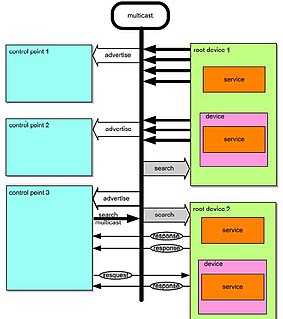Internet Protocol Device Control (IPDC) is a 1998 specification of a communications protocol for voice over Internet Protocol (VoIP) telephony, developed by Level 3 Communications. [1]
Level 3 Communications was an American multinational telecommunications and Internet service provider company headquartered in Broomfield, Colorado. It ultimately became a part of CenturyLink, where Jeff Storey was installed as Chief Operating Officer becoming CEO of CenturyLink one year later in a prearranged succession plan.
IPDC divides the operation of telephony gateways between intelligent call routers in an Internet Protocol (IP) network and simple media gateways at the edge of the IP network and the public switched telephone network (PSTN).
The Internet Protocol (IP) is the principal communications protocol in the Internet protocol suite for relaying datagrams across network boundaries. Its routing function enables internetworking, and essentially establishes the Internet.

A media gateway is a translation device or service that converts media streams between disparate telecommunications technologies such as POTS, SS7, Next Generation Networks or private branch exchange (PBX) systems. Media gateways enable multimedia communications across packet networks using transport protocols such as Asynchronous Transfer Mode (ATM) and Internet Protocol (IP).
The public switched telephone network (PSTN) is the aggregate of the world's circuit-switched telephone networks that are operated by national, regional, or local telephony operators, providing infrastructure and services for public telecommunication. The PSTN consists of telephone lines, fiber optic cables, microwave transmission links, cellular networks, communications satellites, and undersea telephone cables, all interconnected by switching centers, thus allowing most telephones to communicate with each other. Originally a network of fixed-line analog telephone systems, the PSTN is now almost entirely digital in its core network and includes mobile and other networks, as well as fixed telephones.
Internet Protocol Device Control was fused with the Simple Gateway Control Protocol (SGCP), a project independently in progress at Bellcore, to form the Media Gateway Control Protocol (MGCP). This group of protocols employs the media gateway control protocol architecture that is also the foundation of MEGACO/H.248, a similar protocol which became a standards-track protocol at the Internet Engineering Task Force (IETF).
The Simple Gateway Control Protocol (SGCP) is a communications protocol used within a voice over Internet Protocol (VoIP) system. It has been superseded by the Media Gateway Control Protocol (MGCP), another implementation of the media gateway control protocol architecture.
The Media Gateway Control Protocol (MGCP) is a signaling and call control communications protocol used in voice over IP (VoIP) telecommunication systems. It implements the media gateway control protocol architecture for controlling media gateways on Internet Protocol (IP) networks connected to the public switched telephone network (PSTN). The protocol is a successor to the Simple Gateway Control Protocol (SGCP), which was developed by Bellcore and Cisco, and the Internet Protocol Device Control (IPDC).

The media gateway control protocol architecture is a methodology of providing telecommunication services using decomposed multimedia gateways for transmitting telephone calls between an Internet Protocol network and traditional analog facilities of the public switched telephone network (PSTN). The architecture was originally defined in RFC 2805 and has been used in several prominent voice over IP (VoIP) protocol implementations, such as the Media Gateway Control Protocol (MGCP) and Megaco (H.248), both successors to the obsolete Simple Gateway Control Protocol (SGCP).

